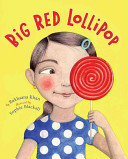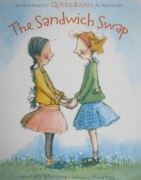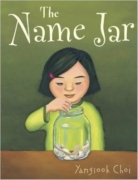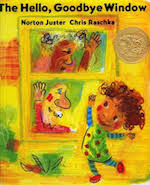A First Grade Classroom’s Perspective
by Barbara Thompson-Book and Cara Farmer
September 2015

Big Red Lollipop, by Rushana Khan, illustrated by Sophie Blackall
Barb: Big Red Lollipop offers readers an opportunity to examine cultural differences in a common experience in the culture of the United States—the birthday party. Rubina is invited to a birthday party and she is very excited. Her mother, however, has a different take on the party. Rubina may go, but she must take her younger sister with her. What follows is an interesting examination of cultural traditions, both different and similar.
What I find most satisfying about this book is that cultural difference is only referenced in the illustrations and one statement by the mother, “why would they do that?” (in reference to the concept of a birthday party). In other ways the story is simply one of a young child having to have a younger sibling “tag along.” Such a universal notion.
Cara: In my first grade class my theme has been Friends for the past week. We have been talking about different types of friends, how we make friends, and how siblings make the best friends. This story came at the perfect time for our class.While we were reading the only thing that my students thought was different was that the mother’s name was Ami and that they didn’t call her mom or mother. Later in a discussion after the story, the students had a conversation about how that didn’t find it odd that the sisters went to the party together. At our school the families are very close. If someone is invited to a party the whole family often is. They were more surprised at the fact that Rubina didn’t want to take Sana. The students didn’t notice much of a cultural difference, they simply thought that their names were special. I agree with Barb. When I read the story I see it as a classic tag along story that reminds me of me and my sister at a young age.
Barb: This surprises me and yet it doesn’t. It just goes to show that even within cultures we think as similar (in this case, white middle class), there is a lot of variation. I do remember being annoyed that when I had a birthday party, my parents made me invite all the kids from my class. We had a pool and my parents felt it was important to share. There are so many discussion points to use with kids, or it’s just a good book.
 The Sandwich Swap by Queen Rania & Kelly DiPucchio, illustrated by Tricia Tusa
The Sandwich Swap by Queen Rania & Kelly DiPucchio, illustrated by Tricia Tusa
Cara: In The Sandwich Swap by Queen Rania two best friends, Lily and Selma, find that they do not have everything in common. Lily loves Peanut Butter and Jelly sandwiches and Selma loves Humus and Pita. When I read this story to my class we were talking about how sometimes friends can have a lot in common and still be different. I work in a school that does not have a lot of ethnic diversity nor are the children exposed to many new things. We shared the story and when it was over I asked them to tell me the details from the story. Several children raised their hands and I called on a little girl. Her comment was “What is a Selma?’’ I realized later when talking that many of my kids are so used to Humus and or Peanut butter that this didn’t affect them. They couldn’t understand making fun of someone’s food, they only thought that Selma was an interesting name. We discussed how all different countries have different names as well as different foods. To me the story is a simple story of differences. At the end of the story I was most proud that many of my students wanted to try Humus and Pita.
Barb: The Sandwich Swap is an interesting book in a couple of ways. First, like Big Red Lollipop, ethnic difference is not explicitly discussed. It is only through language use and actions that it is apparent that both children may not come from the same ethnic group. I find it interesting that Cara’s children were not concerned about the differences in food, but rather that the different names caught their attention. This tends to be the same response in Big Red Lollipop—children are intrigued by the word for mother—Ami.
Second, I find the plot somewhat contrived. That the difference would lead to a large food fight and then a division within the children doesn’t seem authentic. What does seem authentic is the resolution of the issue with all the children sharing foods from their own ethnic heritages. I enjoyed the illustrations and as with Big Red Lollipop, the nuanced examination of difference.
 The Name Jar, by Yangsook Choi
The Name Jar, by Yangsook Choi
Barb: In keeping with our discussion of children navigating their way through cultural differences, this week we explore The Name Jar. When I work with students at the university I always discuss the importance of names. Names are one of the ways in which we identify ourselves within cultural groups. Our names are important to us as ways to frame who we are and how we see ourselves. I tell students this story:
When I was teaching in Arizona, years ago, I had a student who was new to the school in our 4th grade class. On the first day of school he identified himself as Michael. So everyone called him Michael for most of the first year. I held parent/teacher conferences and his mother came and talked with me about Michael. As the year wore on, his mother became more engaged in the classroom and one day during recess she asked me why I called him Michael. I said because he told me that was his name on the first day of school. She said, “Well, I just wondered, because he’s always been called Mikey.” Turns out “Michael” had decided to try out a new name in a new environment. We ended up calling him Mike as we looped with him the next year!
Names can be a discussion topic for the classroom; particularly when children are introduced to names with which they are unfamiliar. Last week Cara shared that some of her students were unfamiliar with the name Selma. While hummus didn’t faze them, this name did. This then lead us to our book of the week this week, The Name Jar. In this book, Unhei has arrived from South Korea, and on the first day of school is teased by another child on the bus about her name. Upon entering her new classroom, she tells the teacher she doesn’t know what her American name will be as she hasn’t picked it yet. Needless to say, her classmates are more than willing to help her choose a new name and thus the “Name Jar” appears on her desk filling up with suggestions from her classmates. What’s a girl to do?
Let’s see what Cara’s first graders thought of the book.
Cara: My students made such a deep connection with this story. I first started out by reading this wonderful story to the kids. This was one that I had not read before. We read the the story and I asked them to retell it for me. They started and then one of them spoke up and said, “You know Ms. Farmer this is kind of how I feel.” We continued to discuss this and it turns out that she had had her name spelled wrong on everything since she started school. This is not just in my class, but in her kindergarten class too. I felt horrible. When I asked her why she hadn’t said anything, she simply said that she felt bad because I had worked so hard to make everything so pretty. After she said this, the kids all had small stories like this. I have a lot of kids in my class with very common names such as Jacob and Kate, but they are spelled Jakob and Cate. They often tell me how this makes them special and stand out, which I think is so sweet. My whole class found this to be such a great discussion that we are making our own book about names. We are talking about what makes our name unique and special. I love how a single book can captivate so many students and teach them how special their name can be.
Once again, we find a book which many might say is a “diversity” book, while having ethnic diverse characters, is really a book about something everyone experiences. Isn’t that the true nature of being human? We are all difference and special in our own ways?
Barb: I can’t wait to see what the first graders have for us next week!
 The Hello Goodbye Window by Norman Juster, illustrated by Chris Raschka
The Hello Goodbye Window by Norman Juster, illustrated by Chris Raschka
Barb: In the Caldecott winning The Hello Goodbye Window the joy of visiting with grandparents or older adults is explored. From the routines established by the unnamed little girl with her grandparents to the experiences she has while in their care, Juster and Raschka bring alive the bonds felt between children and older adults. While many children may not have living grandparents or grandparents who are nearby, the book can be representative of the ties children can make to older adults. While I was growing up on a coast far away from my grandparents, there were several older adults in my neighborhood who served the role of surrogate grandparents. Like the young child in the book, there were certain activities which were routine with many of them: walking in the evening around the block; using their driveway to roller-skate and then hanging our skates from the “skate tree” while we went inside for Kool-Aid and cookies. This book evokes all those memories for me even though my own grandparents were living far away or were gone.
The Hello Goodbye Window has a clear beginning (arriving at the grandparent’s house) middle (all the things they do together while she’s there) and end (leaving for the day) which makes it a nice mentor book for writing lessons on structure. The book is told in the first person, so it is a good example of a narrative piece. It is not told in the past, so it is not a memoir, but could be used to teach memoir if paired with an adult’s own story about his/her own visits to their grandparents. Another nice pairing for this book is Cynthia Rylant and Stephan Gammel’s The Relatives Came.
What I really appreciate about this book is that like the other books we’ve explored this month, while ethnic diversity is present in the book (the grandparents are a bi-racial couple) it is not mentioned. In fact, if you are not paying close attention to the illustrations, you might miss this fact. I wonder what the first graders thought about the book. . .
Cara: My kids didn’t even notice a difference in the grandparents. They loved talking about the things that were the same and different about their relationship with their grandparents. They loved the idea of seeing everyone that comes in their house through the Hello Goodbye window. I think that as they were reading it they thought that it was kind of magical. It was fun seeing them talk about what they would see through the window. They didn’t see the diversity, but they had a wonderful time talking about how much they love their grandparents.
Barb: I suspect that when children are raised in environments in which they are exposed to diverse images and diverse situations on a regular basis, they are unfazed by bi-racial grandparents. Just for fun, next week we’ll read the children Arnold Adoff’s Black is Brown is Tan to see what they think when the topic of being biracial is the subject of the book. See you next week!

Ray and Prisca, Thanks again for reminding us of the power of visual text and the profound affect just one color has on the meaning. I had a conversation a few minutes ago with a colleague who asked me, “At what age do kids begin to read?” When I talked about the visual text and the meaning gained from it, he was surprised. I’m going to share your My Takes with him–I suspect he will never look at picture books the same!
I am a retired teacher who consults with parents of gifted children. A partner and I co-facilitate SENG Model Parent Groups. Fine literature is always a topic! These will be on our list!